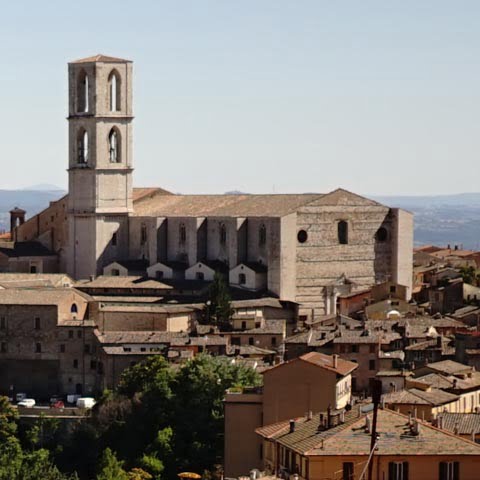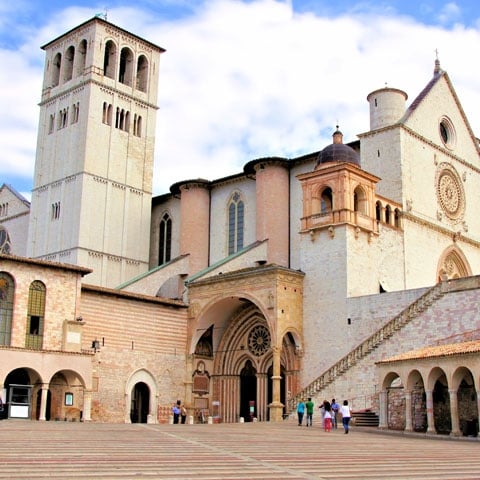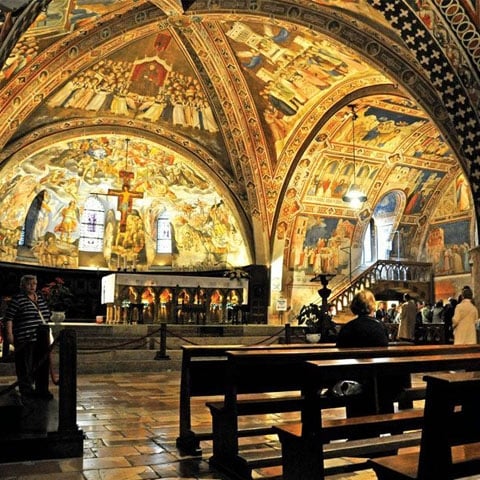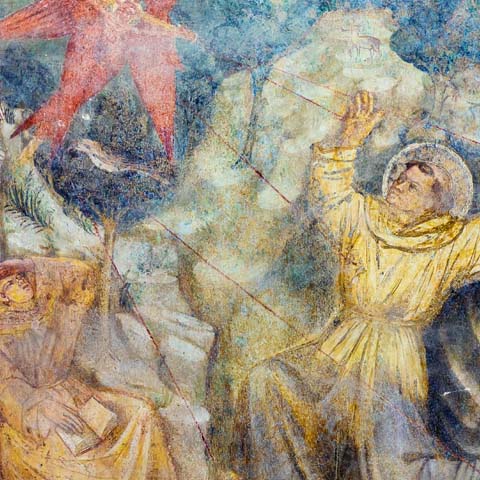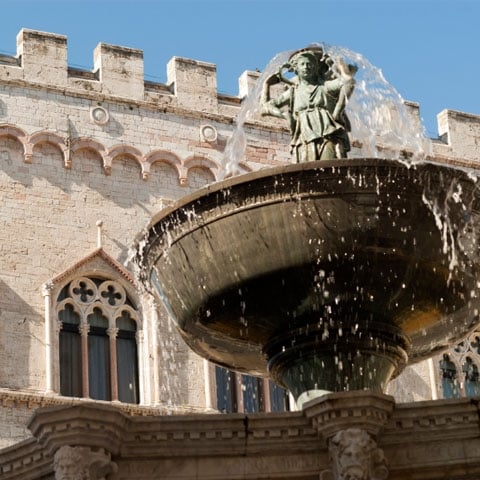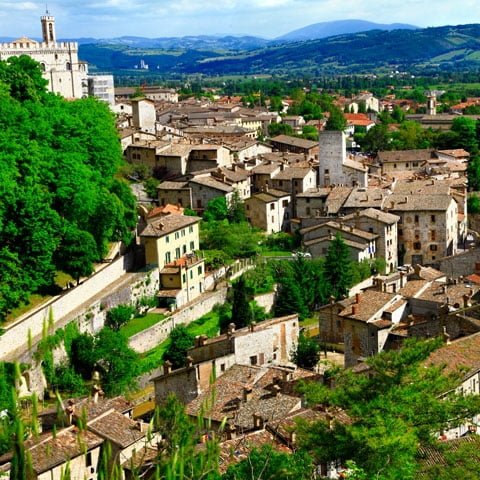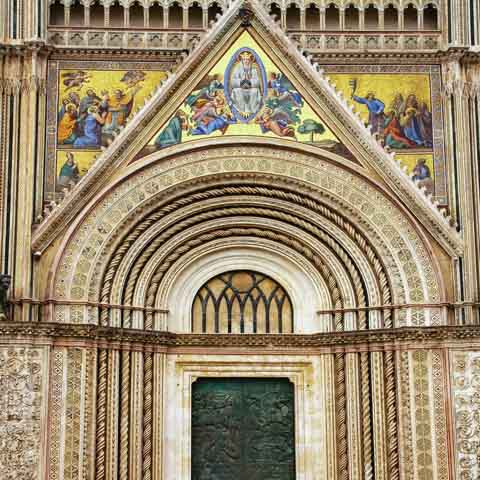While Umbria is primarily known for its lush, green landscape views – a characteristic that earned its
title as the “green heart” of Italy – it is also a region whose architecture, history, and wealth of artistic
offerings make it an open-air museum worthy of being considered a top cultural destination.
Statistically, Umbria has one of the highest number of museums per commune and inhabitant in all of
Italy. This is indicative of the region’s deep-rooted cultural heritage which spans everything from fine
art, to religious history, ancient ruins, music, and more.
What gives Umbria such a rich tapestry of culture? Mainly it’s multifaceted history. Umbria’s past spans
thousands of years. Archeologists have discovered artifacts – specifically flints and arrowheads – that
date as far back as Paleolithic and Neolithic times. Near Spoleto, burial chambers have been found that
indicate human presence in Umbria during the Bronze and Iron Ages. Around 1000 B.C. the first
documented tribe of people – Oscan-Umbrians (Umbri) – established the earliest Umbrian settlements.
These settlements survived to become modern day Umbrian cities such as Terni, Spoleto, Assisi, and
others.
Throughout the middle ages, Umbria was a hot commodity due to its ideal location. It is centrally
located within Italy and is the only region that doesn’t share a border with a neighboring country or sea,
which put the region in a great position strategically. Its land served as a crossroad to both Northern and
Southern Italy, as well as a key passageway between the Adriatic and Tyrrhenian seas on either side of
Italy’s boot. Nearly all trade routes in ancient times had to pass through Umbria. Cities like Foligno –
which can still be visited today – were the center of these commercial pathways due to the road Via
Flaminia, a path that connected Rome to Rimini. The significance of these trade routes at the time
caused Umbria’s culture to be highly influenced by the many diverse types of people who would travel
through it.
First occupied by the Etruscans. followed by the Romans, Umbria’s prime location made it the scene of
many battles for control of the area – hence the many middle age castles and fortress-like architectural
elements who still stand today throughout the region. Modern day cities such as Perugia, Gubbio,
Spoleto, and Todi still have Medieval elements such as towering castles, stone walls, and intricate
ancient architecture.
It is physical artifacts such as these, in addition to the region’s valued folklore, art, music, and literature
that tell the story of the origin of Umbria’s splendid and culturally rich history.
FOLKLORE OF UMBRIA
As a region so heavily defined by its history, it is no wonder that the Umbrian culture is highly defined by
interesting local folklore.
Much of Umbria’s identity comes from its religious history, which is manifested in various ways
throughout the culture. With such iconic religious monuments as the Basilica of Saint Francis of Assisi,
Umbria has served as a pilgrimage destination for centuries. As a result, the region holds a variety of
yearly celebrations held in honor of the region’s many Saints – Francis, Clare, and Rita to name a few.
One of the most famous festivals of religious origin in Umbria is the Festa dei Ceri (Festival of Candles),
also known as Saint Ubaldo Day. Held in May, the event features a race during which three teams carry
massive, heavy symbolic “candles” which are topped by three Saints (St. Ubald, St. George, and Anthony
the Great). The procession crosses the city of Gubbio to the Basilica of St. Ubaldo. This race is such an
important cultural moment in Umbria that Ceri are featured on the Umbrian coat of arms.
Umbria also features events and festivals that celebrate everything from the traditions of Medieval
jousting (Quintana di Foligno, jousting tournament) to ancient archery (Palio of the Crossbow in
Gubbio).
Festivals and events such as these highlight the deep passion the Umbrian people have for their culture,
faith, and history.
ART
Deeply embedded in the Umbrian culture is a solid appreciation of art, and the area has produced many
talented artists.
The Umbrian School, a highly-respected art school of the 15 th -16 th centuries, taught such well-renowned
artists as Piero della Francesca and Raphael. Other important Umbrian artists are Pietro Perugino and
Pinturicchio – both of which were born in the region. Perugino was trained at the Umbrian School, and
went on to become a master painter and teacher of such students as Raphael. Pinturicchio – whose
given name was Bernardino di Betto – was given his nickname, which means “little painter” because he
was small in stature, but not in talent. Painter Allegrini Francesco was also born in Umbria, and his works
influenced the Baroque style of painting in a very influential way.
Umbrian art is typically characterized by religious and Tuscan influences. Being so closely located to
Tuscany, much of Umbrian art during the Renaissance was influence by Tuscan style painters and
techniques. Due to so many important religious Saints throughout the region, Catholic figures,
structures, and symbols were often a subject of local art.
Visitors can experience the depth of Umbrian art in various ways throughout the region. Ancient pieces
of art such as frescoes and paintings can be found all throughout the area – everywhere from the walls
of Umbria’s small churches, to the galleries of famous museums such as the National Gallery of Umbria.
Even contemporary art flourishes in the region. Modern towns such as Trevi, Spoleto, Spello, and
Perugia all feature contemporary art museums that prove that even today, art is very much alive in
Umbria.
LITERATURE
The very name of Umbria is rooted in literature. The Italian phrase commonly used to describe Umbria,
“il cuore verde d'Italia” (the green heart of Italy) is arguably what the region is most known by. This term
was derived from a poem written by Nobel Prize winning, Tuscan poet Giosuè Carducci, and has
continued to define Umbria ever since.
Other influential Umbrian writers include Jacopone da Todi and Giuseppe Prezzolini. Also a monk,
Jacopone da Todi is considered one of Medieval times most important poets. He is known specifically for
“laude,” a special religious style of poetry. Giuseppe Prezzolini, born in Perugia, became one of the most
important people of Italian journalism and literature of the 20 th century. His most famous work was
Codice Della Vita Italiana or Codex of the Italian Life.
MUSIC
Though a region whose artistic styles are mostly reminiscent of old-world Italy, Umbria’s music culture
steps out of the past and into the future.
Every year Umbria is the home of the Umbria Jazz Festival, one of the most important and highly
regarded international jazz festivals in the world. It has featured world-renowned musicians such as
Miles Davis, BB King, Wynton Marsalis, Tony Bennet, and many more.
Another festival held in Umbria that is popular worldwide is the Festival dei Due Mondi (Festival of Two
Worlds). Held in Spoleto it features live opera performances, classical music concerts and dance,
theater, and visual arts performances. A celebration of contemporary art, it brings together American
and European cultures.
These festivals featuring contemporary arts solidify that the region’s artistic impact will continue to be
felt for centuries to come.
The Umbria Region of Italy
Cities of Umbria
